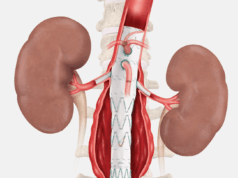 The diameter of an abdominal aortic aneurysm (AAA) may have an important clinical impact on patient outcomes, according to a study of cases contained in the Vascular Quality Initiative (VQI) database.
The diameter of an abdominal aortic aneurysm (AAA) may have an important clinical impact on patient outcomes, according to a study of cases contained in the Vascular Quality Initiative (VQI) database.
The discovery, published in the Journal of Vascular Surgery, was made by Douglas W. Jones, MD, of the division of vascular and endovascular surgery at Boston Medical Center, Boston, and colleagues, who had sought to examine differences in patient selection, operative outcomes and survival after elective endovascular aneurysm repair (EVAR) based on AAA diameter thresholds.
In their rationale, the research team outlined the study backdrop: randomized trials have shown no benefit for repair of small AAAs, they explained, even though it is widely practiced. It has also been suggested that repair of large-diameter AAAs may incur worse outcomes, the researchers added.
In prior studies, EVAR for small AAAs was common,“indicating that many practitioners repair small AAAs on the basis of the presumed, unproven benefit of ‘early repair’ or that practitioners have developed individualized approaches to patient selection that take into account other patientspecific factors thought to modify rupture risk, such as rate of AAA growth, aneurysm morphology, family history of AAA, or gender,” they wrote.
The Society for Vascular Surgery recommends elective AAA repair when the maximum diameter is equal to or greater than 5.5cm in men and 5cm in women.
To carry out their research, the team accessed the VQI database for all EVARs performed from 2003–2017, with 22,975 patients undergoing elective EVAR for AAA. The investigators found that 41% were for small, 47% for medium and 12% for large AAAs.
Only patients undergoing elective EVAR for infrarenal AAAs were studied, the authors noted. In explaining their findings, the investigators wrote: “Patients with small AAAs were younger and had fewer comorbidities. Consequently, patients with small AAAs were more likely to have low predicted operative mortality risk and five-year mortality risk based on risk models (p<0.001 for both).
“For operative outcomes, 30-day mortality was significantly different across diameter categories (small, 0.4%; medium, 0.9%; large, 1.6%; p<0.001). EVAR for large AAAs had the highest rates of multiple medical complications, including myocardial infarction (p<0.001), respiratory complications (p=0.001), and renal complications (p<0.001). In contrast, EVAR for small AAAs had the lowest rates of type I endoleak at completion and reoperation during index hospitalization, shortest operative times, and shortest hospital length of stay (p<0.001 for all).”
Aneurysm diameter was associated with differential one-year, reintervention-free survival (92% small vs. 89% medium vs. 82% large; p<0.001) and five-year overall survival (88% small vs. 81% medium vs. 75% large; p<0.001), the team went on.
Multivariable models further demonstrated that, compared with medium AAAs, small AAAs had an independent protective effect against one-year reintervention or death (HR: 0.82; p=0.003) and five-year mortality (HR: 0.78; p=0.001).
“Conversely, compared with medium AAAs, large AAAs carried an independent increased risk of oneyear reintervention or death (HR: 1.75; p<0.001) and five-year mortality (HR: 1.50; p<0.001),” the researchers added. Asked about these findings, Jones emphasized that “survival rates for patients undergoing EVAR for small AAAs in the VQI are comparable to those seen in the surveillance arms of randomized controlled trials examining the utility of EVAR for small AAAs. Although these data illustrate that longterm survival is associated with AAA diameter at the time of EVAR, they should not be misinterpreted as supportive of EVAR for small AAAs over surveillance.”
“Small AAAs account for more than 40% of EVAR procedures in the VQI,” the researchers concluded. “Patients with small AAAs selected for repair are younger and have fewer comorbidities and consequently lower risk of operative and five-year mortality. Conversely, large AAA EVAR is associated with the worst operative and five-year mortality. Aneurysm diameter is independently associated with reinterventions and mortality after EVAR, suggesting that AAA diameter may have an important clinical effect on outcomes.”
Source: DOI:org/10.1016/j.jvs.2019.02.053












